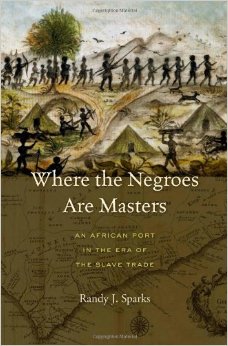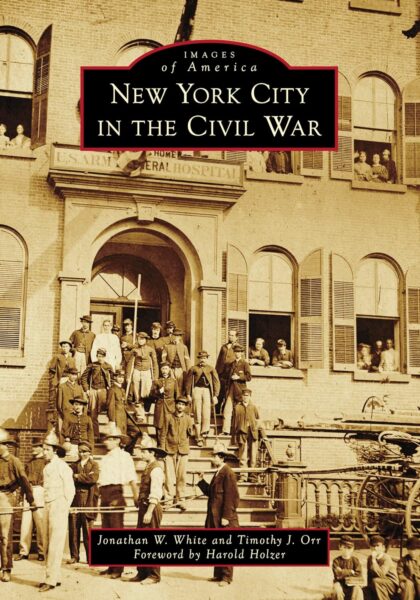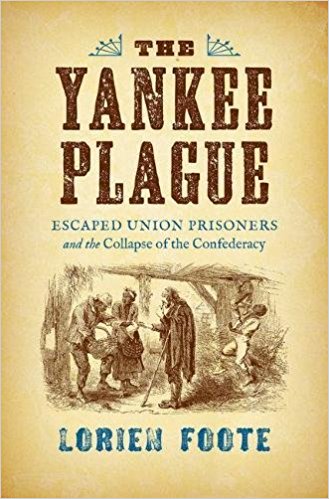Where the Negroes Are Masters: An African Port in the Era of the Slave Trade by Randy J. Sparks. Harvard University Press, 2013. Cloth, ISBN: 0674724879. $29.95.
 As plantation owners sold commodities to merchant vessels in the Americas, a simultaneous and connected transaction occurred across the Atlantic. The power dynamics driving this exchange at Annamaboe, a Fante-controlled port located on the West African coast, is chronicled in Randy J. Sparks’ Where the Negroes are Masters: An African Port in the Era of the Slave Trade. Its premise is simple: at Annamaboe, Africans held the power and Europeans merely served at the Africans’ pleasure. By positioning Africans as power brokers with incredible leverage rather than mere bit players, Sparks’ work offers insights that continue a corrective trend in the slave trade historiography.
As plantation owners sold commodities to merchant vessels in the Americas, a simultaneous and connected transaction occurred across the Atlantic. The power dynamics driving this exchange at Annamaboe, a Fante-controlled port located on the West African coast, is chronicled in Randy J. Sparks’ Where the Negroes are Masters: An African Port in the Era of the Slave Trade. Its premise is simple: at Annamaboe, Africans held the power and Europeans merely served at the Africans’ pleasure. By positioning Africans as power brokers with incredible leverage rather than mere bit players, Sparks’ work offers insights that continue a corrective trend in the slave trade historiography.
To directly tackle the question of power, Sparks addresses a number of issues — not least of all the physical, hypnotic presence of forts along the West African littoral. These structures have invoked thoughts of European imperial might, calling to mind the hegemony that accompanied their colonization of the Americas. Sparks points out, however, that forts on the West African coast were only trading establishments — a point from which a few European merchants defended their trade with African merchants against their European rivals in what had become a sort of “game of thrones.” For Sparks, nothing illustrates this point more clearly than the fact that cannons in forts like Annamaboe pointed toward the open Atlantic at approaching European vessels rather than at African states inland.
Sparks demystifies the dynamics of the slave trade to show colossal, interconnected, and unseen dimensions of the Atlantic world system. He observes how the Fantes’ initial exchange of African gold for European cloth and other commodities at Annamaboe shifted to a trade in slaves as plantation slavery in the Americas grew dramatically. Sparks points out how different power players on the coast — such as Fante rulers, chiefs, and caboceers — jealously guarded the profitable trade, while their Portuguese, British, Dutch, and French trading partners competed amongst themselves to monopolize it. Pawning, an indigenous African trade practice in which family members became collateral, lent itself to African-European socio-economic relationships, which proved critical to the expanding slave trade. These transactions, hinging on familial consent, personal connections, African-European cultural exchange, and a delicate balance of trust, worked together to facilitate the development of the slave trade at Annamaboe. It was this dynamic that ultimately distinguished the business of slave trading from piracy and kidnapping.
In Atlantic history, slavery has assumed a central and immoveable presence, critical to the shaping of identity in the African diaspora, its ethics, and politics. Following its demise, efforts to hold Western powers responsible for slavery’s enduring legacies led to a historiographic line of argument that Europeans had acquired slaves through kidnapping, rather than from genuine trade with African merchants. Operating from this view, diasporic scholars “excised language of African power” from the slave trade literature. Putting Africans in positions of power during the slave trade meant incurring a collective guilt in remembering (memory) and (re)membering (collectivizing) Africa and the diaspora. Yet the failure to acknowledge African power during the slave trade era had epistemological, ontological, and psychological outcomes, and the victimology discourse that it ultimately serviced permeated many aspects of black life. Admittedly, this school of thought has been in decline for some time. Nonetheless, Sparks’ injection of new life into this historiography makes his work necessary and welcomed.
At the outset of Where the Negroes are Masters, Sparks weaves together the interconnected worlds of the Atlantic to tell the story of an African Prince who was kidnapped and sold into slavery, but who was nonetheless able to return home on account of his powerful family. Though the author gracefully moves from Annamaboe to South Carolina labor demands, and to expanding European capitalism, one never quite grasps a deeper sense of how power changed hands and mutated across these spaces and over time. In this notoriously slippery Atlantic world, Sparks’ focus remains on Africans exercising power from within a circumscribed spatial and temporal position. But the kind of African power exercised at Annamaboe rarely crossed the ocean into the diaspora, or into the African present. Rather, it was the heartbeat of anti-African racism that persisted in Africa, the Americas, and Europe well after slavery ended – facilitating various kinds of legal, political, and economic exclusion quite contrary to the power Africans held in the port at Annamaboe. In this regard, a greater exploration of the tenuous nature of power in the Atlantic world might have enhanced Sparks’ work.
Nonetheless, by exploring Africans’ place in the slave trade at the Annamaboe slave port, Sparks highlights a pivotal way in which the dynamics of the Atlantic world facilitated different manifestations of power.
Caree A. Banton is Assistant Professor of African & African American Studies and History at the University of Arkansas. She earned her Ph.D. at Vanderbilt University with a dissertation entitled, “More Auspicious Shores: Post-Emancipation Barbadian Emigrants in Pursuit of Freedom, Citizenship, and Nationhood in Liberia, 1834 – 1912.”




